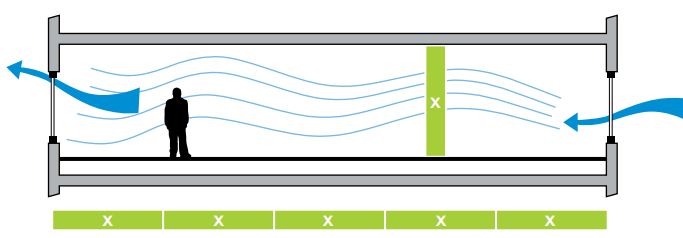Openings in building envelopes are major design elements in any building. They not only connect you to the outer world but are also a way of getting fresh air into the interiors. Natural-ventilation, also called Passive-ventilation is a method of supplying fresh air and removing stale air from a space. It does not use any mechanical means to carry out this process. Mechanical means consume energy, may emit harmful substances and contribute towards global-warming. Natural ways are always economic and nature-friendly.
There are three methods to carry out natural ventilation:
- Single-sided ventilation
- Cross-ventilation
- Stack effect
Methods to carry Out Natural Ventilation:
1. Single-Sided Ventilation
This method involves having openings only on one external wall and generally towards the wind-direction. Air exchange happens through wind turbulence. Single-sided ventilation is not used as often as it is ineffective compared to the other two ways.


2. Cross-Ventilation
In this method, openings are located such that the ones at the receptive end allow maximum inflow of fresh air and the outlet openings are placed such that the air gets circulated in the space efficiently and is pushed out with the inflow of fresh air.
In areas with high wind speeds, smaller openings are preferred in the wind-ward directions and larger in the lee-ward or exhaust direction. In case of lower wind speeds, the opposite of the previous is preferred to get better quality air.


3. Stack Effect
This method is based on the fact that cooler air is light in weight and hot and stale air is heavier. Receptive openings are given on the lower sides in the wind-ward directions and for outlet, openings are given on the upper side. This arrangement pushes out the stale air from the space whenever fresh air is drawn inwards.


Advantages of Natural Ventilation System
- Energy saving
Buildings are one of the highest energy-consumers and producers of carbon dioxide. Natural ventilation systems do not emit carbon dioxide or any other harmful substance. They do not require electricity or any other fuel to carry out ventilation
- No pipelines and ducting
Unlike mechanical ventilation or air-conditioners, natural methods do not require pipelines or ducts which incur extra expenditure and also in some cases spoil the aesthetics of the building
- More natural light
Anything natural is good for health. At least, most of the times. Large openings not only bring in more natural air but also more natural light. In case of harsh sunlight, you can always cover them up with beautiful drapes!
- Efficient use of space
Air handling units or any other machinery require space for installation, whereas, natural ventilation needs only openings. The space that could be occupied with machinery can now be used for various other purposes.
- Low maintenance
The absence of pipes, ducts and machinery will need no maintenance except for regular dusting the openings, which, is definitely not a herculean task!
- Less expensive
Except for spending on frames, shutters and drapes for openings, there is no expenditure for anything else. No machinery means, no extra costs. Fresh air is free, isn’t it?
- Less health-issues
Mechanical ways might cause disorders and unpleasant sounds (if machines are not maintained properly). Natural ventilation can reduce such sick-building syndrome symptoms.
Factors on Which Natural Ventilation Depend:
Natural ventilation is dependent on factors like:
- Wind direction and Orientation of building
North-East and South-West are generally considered as the direction of winds. Therefore, the placement of openings should be done considering these directions
- Topography
An uneven topography may hinder the movement of wind due to which the placement, size and types of openings may be altered.
- Vegetation / Landscape
Having more vegetation definitely cools the surroundings and absorbs noise. But, apart from these, trees also act as source of fresh hair.
- Size and types of Openings
Avoid parallel placing of inlets and outlets and partitions near inlets. Openable windows are more efficient as they could be closed and opened whenever required. Glass panels could be used for shutters to get sunlight even while shutters are closed.
– Yashaswini Poddar


